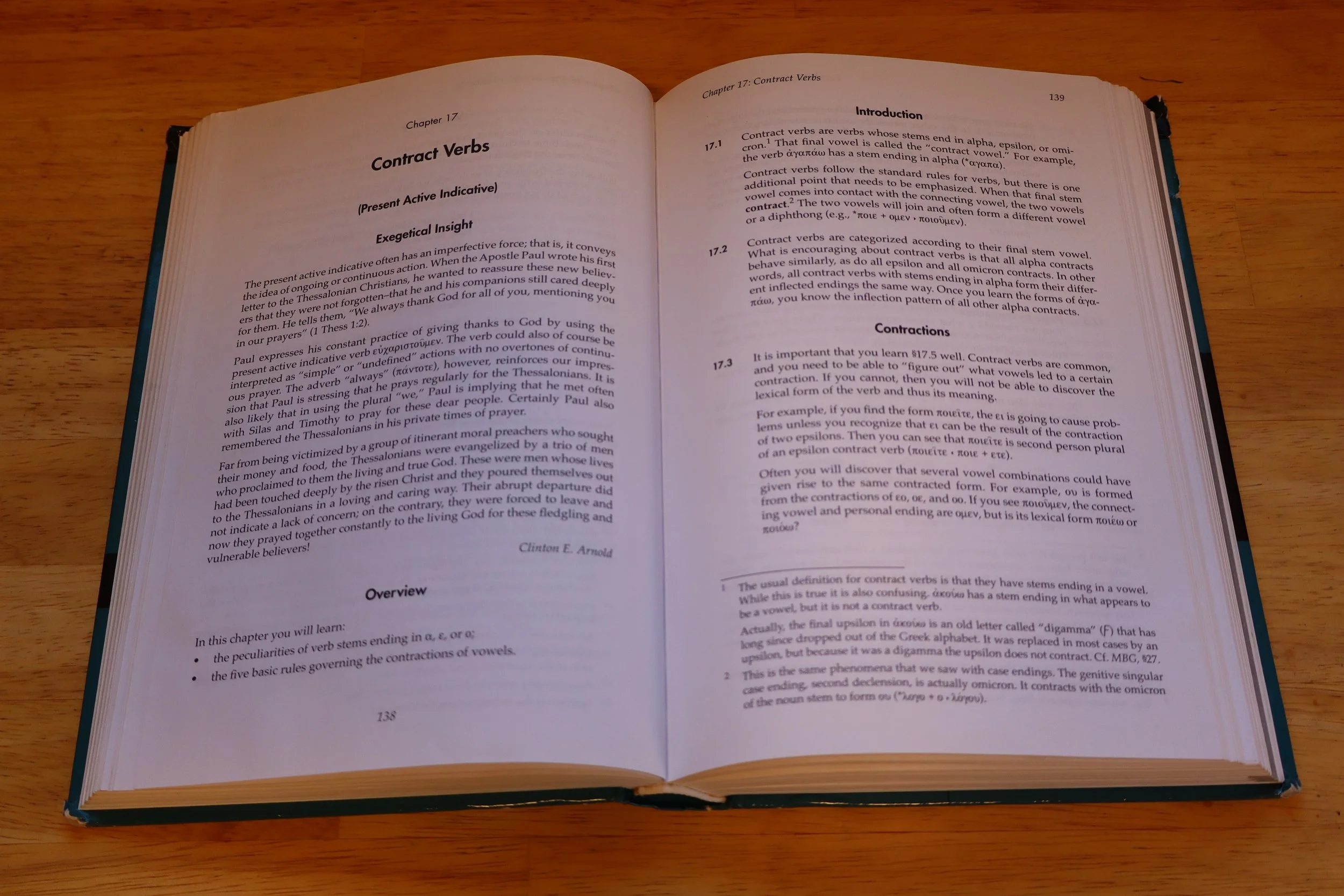Mastering the Language of the New Testament: Basics of Biblical Greek Grammar, Fourth Edition
William D. Mounce's Basics of Biblical Greek Grammar (Fourth Edition) is widely regarded as the standard introductory textbook for learning New Testament Greek. Since its first publication in 1993, it has helped over 400,000 students in seminaries, colleges, and independent study programs worldwide. It has become a cornerstone for students and scholars learning Koine Greek, the language of the New Testament. Published by Zondervan Academic, this edition builds on previous versions to provide a clear, accessible path into the study of Greek. One of the great things about this book are the homiletical discussions on the text. The essays on grammar concepts shows the depth of the Biblical text. It’s not just a dry resource book, but has beautiful sermon-like exegetical discussions to put the grammar you learn into practical use and to enrich your faith.
This article explores the updates, structure, and educational impact of this latest edition:
Clear and Logical Structure
Mounce’s teaching methodology is highly systematic. The grammar is presented in a step-by-step manner, with each concept building on the previous one. This progression helps students grasp the complexities of Greek syntax and morphology without feeling overwhelmed. Unlike traditional approaches that focus on rote memorization, Basics of Biblical Greek emphasizes understanding linguistic principles, making learning more intuitive and less daunting for beginners.
Focus on Practical Vocabulary
One of the key strengths of this edition is its focus on vocabulary that appears frequently in the New Testament. By the end of the course, students will have learned all Greek words that occur 50 times or more, providing them with a solid foundation for reading the New Testament. The emphasis on practical vocabulary ensures that learners can quickly start recognizing words in real biblical texts.
Enhanced Pedagogical Features
The fourth edition includes several new and updated features designed to improve the learning experience:
Adjective decision trees help students distinguish between different grammatical functions.
Earlier introduction of verb transitivity improves understanding of sentence structure from the start.
Expanded use of manuscript images and improved typography make the text more engaging and easier to read.
Additionally, Mounce has incorporated new insights from linguistic scholarship, ensuring the content remains current and relevant to modern biblical studies.
Supplementary Learning Aids
A major advantage of using Basics of Biblical Greek is the availability of a comprehensive suite of supplementary materials:
A workbook for practice exercises.
Video lectures by Mounce that align with each chapter of the textbook.
Flashcards for vocabulary memorization.
Audio recordings to aid with pronunciation.
These resources make the textbook accessible for different learning styles and provide ample opportunities for practice outside of the classroom.
This textbook is designed to take students from the basics of Greek grammar to a level where they can begin reading the New Testament with confidence. Here's what the fourth edition brings to the table:
Key Features:
Updated Content: The fourth edition includes new explanations, exercises, and vocabulary, reflecting feedback from instructors and students to clarify complex concepts.
User-Friendly Layout: Known for its clear typography and logical sequencing, the book has been further refined for ease of use, with each chapter building on the last.
Grammar and Syntax: It covers all essential aspects of Greek grammar, including nouns, verbs, adjectives, participles, infinitives, and more advanced syntactical constructions.
Vocabulary Building: Mounce includes a strategic approach to learning vocabulary, focusing on words that appear frequently in the New Testament.
Practice Exercises: Each chapter includes exercises for practice, from parsing to translation, with answers provided in a separate workbook.
Digital Resources: Alongside the textbook, there's an array of digital resources, including flashcards, audio recordings for pronunciation, and video lectures by Mounce, enhancing the learning experience.
Exegesis: The book introduces students to the basics of exegesis, encouraging them to apply their Greek knowledge to biblical interpretation.
Significance in Greek Studies:
Educational Standard: Widely adopted in seminaries, universities, and by independent learners, it's become a standard for introductory Greek courses.
Accessibility: Mounce's approach makes Greek less intimidating for beginners, with explanations that are both thorough and understandable.
Preparation for Ministry: For those preparing for pastoral or teaching roles, this grammar provides the foundation needed to engage with the New Testament in its original language.
Structure and Utility:
Chapters: Organized into 35 chapters, each focusing on a specific grammatical or syntactical element, gradually increasing in complexity.
Review Sections: Periodic reviews help consolidate learning, preparing students for reading actual biblical texts.
Appendices: Include reference materials like verb charts, principal parts lists, and a comprehensive vocabulary.
Pronunciation Guide: Aids in teaching the correct pronunciation of Greek, which is crucial for proper language learning.
Impact and Reception:
Positive Feedback: Educators and students praise the clarity of instruction, the logical progression of topics, and the supportive digital materials.
Adoption: Its widespread use in educational settings underscores its effectiveness in teaching Greek.
Community: The "Basics of Biblical Greek" community, including forums and study groups, has grown around Mounce’s resources, fostering collaborative learning.
"Basics of Biblical Greek Grammar" by William D. Mounce in its fourth edition continues to be an essential tool for anyone embarking on the journey of learning New Testament Greek. Its commitment to clarity, combined with an array of learning aids, makes the daunting task of mastering an ancient language more approachable. Whether for academic study, theological education, or personal enrichment, this grammar provides a solid foundation for engaging with the New Testament in its original language, encouraging a deeper understanding and appreciation of the biblical text.
This is a great resource for anyone serious about studying New Testament Greek. Its clear structure, practical vocabulary, updated content, and extensive supplementary materials make it one of the most effective tools available for beginners. Whether you're a student in a formal program or a self-learner, this textbook offers everything you need to build a strong foundation in biblical Greek.


